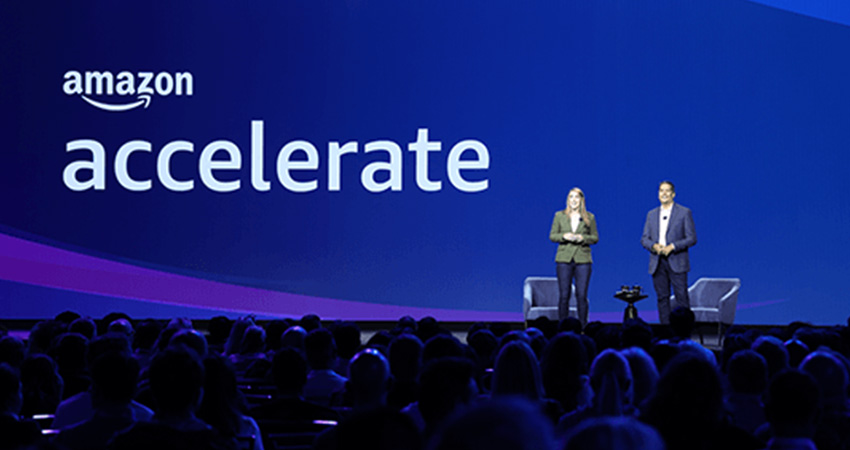If there’s anyone who can grab the brass ring of a true end-to-end supply chain offering, which many providers have talked up for years and worked to cobble together, the smart money would be on Amazon, as the company awaits the hammer drop of an FTC antitrust action.
Ahead of its Accelerate seller conference in Seattle, running today and Thursday, Amazon announced a raft of interconnected services Tuesday, branded as Supply Chain by Amazon. It handles everything from logistics and forwarding from point of origin all the way to the customer’s door. For the first time, Amazon is offering its sellers bulk storage, distribution and replenishment across channels from the same optimized inventory pool, including retail stores.
In essence, Amazon is building a walled garden of supply chain and logistics services such that its sellers, who make up more than 60% of Amazon.com sales, incented through programs and discounts, need never wander outside. And major retailers may take advantage of it, as well.
Mega Suite Expands Competition
The new mega-suite of supply chain services puts Amazon in competition with cross-border service providers who optimize customs clearance, freight forwarding and shipping, major parcel carriers and third-party logistics (3PL) on the domestic side that Fulfillment By Amazon (FBA) goes up against.
“Supply Chain by Amazon is an end-to-end, fully automated set of supply chain services that provides sellers a complete solution with quality and reliability from manufacturer to customer around the world,” Piyush Saraogi, VP Worldwide for FBA, said in an interview. “Advanced technology and supply chain expertise optimizes all the end-to-end logistics, fulfillment and transportation.”
Amazon Global Logistics (AGL), an existing service that handles millions of packages daily, provides shipping from manufacturing hubs in China and elsewhere, which the company is expanding. It also handles customs clearance, ocean and air freight.
Incentives and Discounts
Amazon is offering a 25% discount for AGL on all shipments bound for Amazon Warehousing and Distribution facilities (AWD). That program was beta tested with a few retailers in 2022 and is now being expanded to general availability. AWD provides bulk product storage, much like a retailer’s distribution center network, at an 80% discount to FBA. Also, Amazon said, there will be no peak season surcharge for the service.
A Partner Carrier program provides discounts of up to 25% on transportation services from port to AWD facilities.
Saraogi said Amazon’s inventory management software automates stock positioning based on demand patterns. “Algorithms determine how much product to put into FBA, to be closer to customers across the country, or to automate DC replenishment,” he said. “It determines the right product at the right quantity and the right time.”
From there, Amazon’s new Multi-Channel Distribution (MCD) handles product replenishment in online and offline channels, including shipping to a merchant’s warehouse or their logistics partner. It is currently being piloted by select retailers and will have general availability later this year.
And if all this wasn’t enough, there is also Amazon Shipping, a ground service for non-FBA sellers that taps its Delivery Service Provider (DSP) network shuttling packages from local hubs to customers’ doors. It handles orders from Amazon.com as well as the seller’s own website and other channels, including product pickup from their warehouse. At the same time, it’s competing with FedEx, UPS, the U.S. Postal Service and regional carriers for that business.
Saraogi said sellers can use the various services under Supply Chain By Amazon in an a la cart manner, “or go end-end to get the benefits of the whole thing.”
Going Beyond Sellers, Deepening Hooks
Brittain Ladd, a strategy advisor with private equity firm Shatranj Capital Partners, sees Amazon going beyond its sellers to retailers more broadly now that this broad suite is in place. He said the walled garden analogy was apt.
“Amazon can go to Starbucks, Gap, Caterpillar, John Deere and all of the auto parts retailers like Auto Zone, Pep Boys and O’Reilly,” said Ladd, who handled third-party logistics management for Amazon. “They can make the case for providing all supply chain and logistics services including managing spare parts inventory, replenishing stores and dealerships, and providing same-day delivery in most areas, regardless of the industry.”
Ladd said he could even envision a “phase 2” of Amazon Shipping, where end customers ask for a pickup when their package is being delivered. “Amazon will box the product and complete the transaction before they depart,” he said. “It’s one more way for them to own the home through their services.”
Colin Sebastian, a managing director and senior analyst with Baird, said Amazon was “picking up where they left off” after pausing third-party offerings when the massive wave of pandemic demand shelved it.
“Ultimately, Amazon will offer logistics, fulfillment and delivery as services much like they do cloud infrastructure,” Sebastian said. “It’s a cost-effective means for them to leverage the network built for their core business, which other companies can then use.”
The “symbiotic relationship” lets the company scale and gain efficiency, Sebastian said, “and gives them a significant amount of additional data” to fuel other businesses and spin the flywheel.

